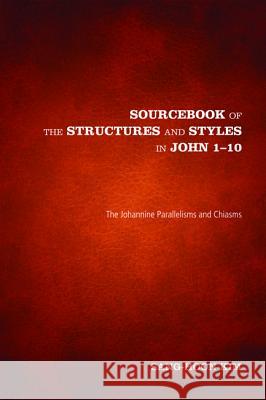Sourcebook of the Structures and Styles in John 1-10 » książka
Sourcebook of the Structures and Styles in John 1-10
ISBN-13: 9781625644923 / Angielski / Miękka / 2014 / 342 str.
No other book in the New Testament compares to John in its complexity of style and structure. So many factors confuse Johannine scholars, including the complexity of styles, repetition, duplication, and seemingly distracted structures that are difficult to discern. Sourcebook of the Structures and Styles in John 1-10 is designed to scrutinize the structures and styles in John 1-10, reading John according to John's way, with the following integrated points of view: First, this reading is indebted to both diachronic and synchronic approaches. Second, macro structure and micro style are treated together and interactively. Third, specific and overall analyses are made together. Fourth, grammatical and relational considerations are brought together. Fifth, syntactic, semantic, and pragmatic relations are considered all together. Sixth, both parallelisms and chiasms (including their variations) are examined, whether in macro structure or in micro style, without excluding either. Seventh, all types of parallelisms and chiasms are examined, whether simple or complex. Eighth, ancient and modern ways in writing-reading processes complement each other. Ninth, Western and Eastern perspectives become complementary. Tenth, the Greek text and its English version (by the author) are used interactively. Eleventh, analysis and discussion are brought to complement one another. Sang-Hoon Kim is Associate Professor of New Testament at Chongshin University and Seminary in Seoul, South Korea.
No other book in the New Testament compares to John in its complexity of style and structure. So many factors confuse Johannine scholars, including the complexity of styles, repetition, duplication, and seemingly distracted structures that are difficult to discern. Sourcebook of the Structures and Styles in John 1-10 is designed to scrutinize the structures and styles in John 1-10, reading John according to Johns way, with the following integrated points of view: First, this reading is indebted to both diachronic and synchronic approaches. Second, macro structure and micro style are treated together and interactively. Third, specific and overall analyses are made together. Fourth, grammatical and relational considerations are brought together. Fifth, syntactic, semantic, and pragmatic relations are considered all together. Sixth, both parallelisms and chiasms (including their variations) are examined, whether in macro structure or in micro style, without excluding either. Seventh, all types of parallelisms and chiasms are examined, whether simple or complex. Eighth, ancient and modern ways in writing-reading processes complement each other. Ninth, Western and Eastern perspectives become complementary. Tenth, the Greek text and its English version (by the author) are used interactively. Eleventh, analysis and discussion are brought to complement one another.Sang-Hoon Kim is Associate Professor of New Testament at Chongshin University and Seminary in Seoul, South Korea.











